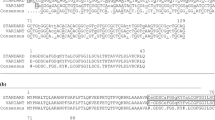Abstract
BLAST analysis of the rat genome revealed the presence of 16 pseudogenes of isoform 1 of the mitochondrial voltage-dependent anion channel (VDAC1). Based on their structural characterization, it was concluded that these pseudogenes were formed by integration of VDAC1 cDNA into the genome, and subsequent rearrangements/mutations. By RT-PCR analysis using carefully designed primers that could not amplify the cDNA of genuine VDAC1, 8 of these 16 pseudogenes showed slight expression in certain tissues, but none of them seemed to encode a functional protein.


Similar content being viewed by others
References
Blachly-Dyson E, Forte M (2001) VDAC channels. IUBMB Life 52:113–118
Cesar Mde C, Wilson JE (2004) All three isoforms of the voltage-dependent anion channel (VDAC1, VDAC2, and VDAC3) are present in mitochondria from bovine, rabbit, and rat brain. Arch Biochem Biophys 422:191–196
Chomczynski P, Sacchi N (1987) Single-step method of RNA isolation by acid guanidinium thiocyanate–phenol–chloroform extraction. Anal Biochem 162:156–159
Colombini M (2007) Measurement of VDAC permeability in intact mitochondria and in reconstituted systems. Methods Cell Biol 80:241–260
Decker WK, Bowles KR, Schatte EC, Towbin JA, Craigen WJ (1999) Revised fine mapping of the human voltage-dependent anion channel loci by radiation hybrid analysis. Mamm Genome 10:1041–1042
Mathupala SP, Ko YH, Pedersen PL (2006) Hexokinase II: cancer’s double-edged sword acting as both facilitator and gatekeeper of malignancy when bound to mitochondria. Oncogene 25:4777–4786
Messina A, Oliva M, Rosato C, Huizing M, Ruitenbeek W, van den Heuvel LP, Forte M, Rocchi M, De Pinto V (1999) Mapping of the human voltage-dependent anion channel isoforms 1 and 2 reconsidered. Biochem Biophys Res Commun 255:707–710
Mighell AJ, Smith NR, Robinson PA, Markham AF (2000) Vertebrate pseudogenes. FEBS Lett 468:109–114
Palmieri F (2004) The mitochondrial transporter family (SLC25): physiological and pathological implications. Pflugers Arch 447:689–709
Sampson MJ, Lovell RS, Craigen WJ (1997) The murine voltage-dependent anion channel gene family. Conserved structure and function. J Biol Chem 272:18966–18973
Shinohara Y, Sagawa I, Ichihara J, Yamamoto K, Terao K, Terada H (1997) Source of ATP for hexokinase-catalyzed glucose phosphorylation in tumor cells: dependence on the rate of oxidative phosphorylation relative to that of extramitochondrial ATP generation. Biochim Biophys Acta 1319:319–330
Shinohara Y, Ishida T, Hino M, Yamazaki N, Baba Y, Terada H (2000) Characterization of porin isoforms expressed in tumor cells. Eur J Biochem 267:6067–6073
Yamamoto T, Yamada A, Watanabe M, Yoshimura Y, Yamazaki N, Yoshimura Y, Yamauchi T, Kataoka M, Nagata T, Terada H, Shinohara Y (2006) VDAC1, having a shorter N-terminus than VDAC2 but showing the same migration in an SDS-polyacrylamide gel, is the predominant form expressed in mitochondria of various tissues. J Proteome Res 5:3336–3344
Yamamoto T, Yamamoto A, Watanabe M, Matsuo T, Yamazaki N, Kataoka M, Terada H, Shinohara Y (2009) Classification of FABP isoforms and tissues based on quantitative evaluation of transcript levels of these isoforms in various rat tissues. Biotechnol Lett 31:1695–1701
Zhang Z, Gerstein M (2003) The human genome has 49 cytochrome c pseudogenes, including a relic of a primordial gene that still functions in mouse. Gene 312:61–72
Zhang Z, Gerstein M (2004) Large-scale analysis of pseudogenes in the human genome. Curr Opin Genet Dev 14:328–335
Zhang Z, Harrison P, Gerstein M (2002) Identification and analysis of over 2000 ribosomal protein pseudogenes in the human genome. Genome Res 12:1466–1482
Author information
Authors and Affiliations
Corresponding author
Additional information
Y. Ido and T. Yamamoto contributed equally to this work.
Electronic supplementary material
Below is the link to the electronic supplementary material.
Rights and permissions
About this article
Cite this article
Ido, Y., Yamamoto, T., Yoshitomi, T. et al. Pseudogenes of rat VDAC1: 16 gene segments in the rat genome show structural similarities with the cDNA encoding rat VDAC1, with 8 slightly expressed in certain tissues. Mamm Genome 23, 286–293 (2012). https://doi.org/10.1007/s00335-011-9375-x
Received:
Accepted:
Published:
Issue Date:
DOI: https://doi.org/10.1007/s00335-011-9375-x




